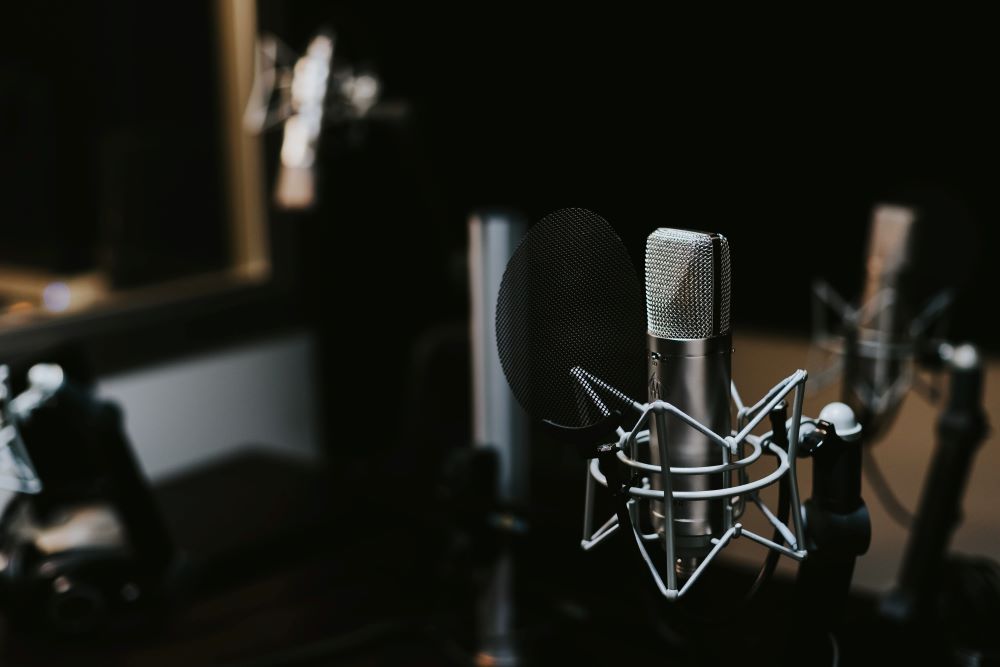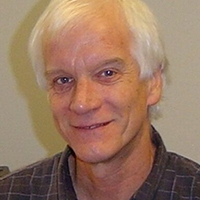Renowned recording engineers Jack Renner of Telarc Records and Marc Aubort of Nonesuch Records describe spaced omnidirectional microphones as their favorite technique for stereo recording of symphonic ensembles.
Of all the stereo mic techniques available, the “spaced-omni” method is especially good at providing a warm, full sound (deep low-frequency response) and a spacious sense of ambience. It adds up to a pleasant listening experience.
We’ll explore how this technique – and others – can be beneficial.
Spaced Pair
With the spaced-pair method (also called AB), you place two identical mics a few feet apart and aim them straight ahead (Figure 1). The mics can have any polar pattern, but omni is most popular for this method. The greater the spacing between mics, the greater the stereo spread.
How does this method work? Instruments in the center of the group produce the same signal from each mic.
When you monitor the mics, you hear a phantom image of the center instruments midway between your loudspeakers.
If an instrument is off-center, it is closer to one mic than the other, so its sound reaches the closer microphone before it reaches the other one. Both mics produce the same signal, except that the farther mic’s signal is delayed compared to the closer mic’s signal.
If you send the same signal to two speakers with the signal in one channel delayed, the sound image shifts off center. With a spaced-pair recording, off-center instruments produce a delay in one mic channel, so they are reproduced off center.
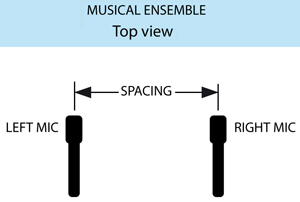
The spaced pair codes instrument positions into time differences between channels. During playback, the brain decodes these time differences back into corresponding image locations.
A delay of 1.2 millisecond (msec) is enough to shift an image all the way to one speaker. You can use this fact when you set up the mics. Suppose you want to hear the right side of the orchestra from the right speaker.
The sound from the right-side musicians must reach the right mic about 1.2 msec before it reaches the left mic. To make this happen, space the mics about 2 to 3 feet apart.
This spacing makes the correct delay to place right-side instruments at the right speaker. Instruments partway off center produce interchannel delays less than 1.2 msec, so they are reproduced partway off center.
If the spacing between mics is, say, 12 feet, then instruments that are slightly off center produce delays between channels that are greater than 1.2 msec. This places their images at the left or right speaker. I call this “exaggerated separation” or a “ping-pong” effect.
On the other hand, if the mics are too close together, the delays produced will be too small to provide much stereo spread. Also, the mics will tend to emphasize instruments in the center because the mics are closest to them.
The spaced-pair method tends to make off-center images unfocused or hard to localize. Why? Spaced-pair recordings have time differences between channels.
Stereo images produced solely by time differences are not very sharp. You still hear the center instruments clearly in the center, but off-center instruments are harder to pinpoint. Spaced-pair miking is a good choice if you want the sonic images to be diffuse or blended, instead of sharply focused.
Another flaw of spaced mics: If you mix both mic channels to mono, you may get phase cancellations of various frequencies. This may or may not be audible.
Spaced mics, however, give a “warm” sense of ambience, in which the concert-hall reverb seems to surround the instruments and, sometimes, the listener. Here’s why: The two channels of recorded reverb are incoherent; that is, they have random phase relationships. Incoherent signals from stereo speakers sound diffuse and spacious.
Because spaced mics pick up reverb incoherently, it sounds diffuse and spacious. The simulated spaciousness caused by the phasiness is not necessarily realistic, but it is pleasant to many listeners.
This lack of correlation between channel signals shows up on a correlation meter. For example, the IK Multimedia T-Racks 3 mastering software includes a correlation meter, which shows almost zero correlation between channels for the spaced-pair technique. It shows 0.3 to 0.5 correlation (out of 1) for the N.O.S near-coincident technique.
Another advantage of the spaced pair is that you can use omni mics. Because of the physics of their operating principles, an omnidirectional condenser mic has deeper bass than a unidirectional condenser mic.
A typical studio omni condenser mic—of any size—has a flat response down to 20 Hz. A typical small-diaphragm cardioid condenser mic is flat down to 100 Hz, and 3 to 4 dB down at 50 Hz at 1 meter from the sound source. (These specs are from ACO Pacific, Neumann and Schoeps.)
Let’s compare the spaced-pair method to other stereo techniques.
Coincident Pair
With this method (also called XY), you mount two directional mics with grilles touching, diaphragms one above the other, and angled apart (Figure 2).
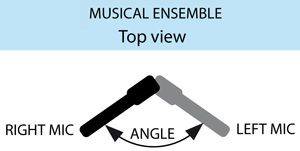
For example, mount two cardioid mics with one grille above the other, and angle them 120 degrees apart. You can use other patterns too: supercardioid, hypercardioid, or bidirectional. The wider the angle between mics, the wider the stereo spread.
How does this technique make images we can localize? Recall that a directional mic is most sensitive to sounds in front of the mic (on-axis) and progressively less sensitive to sounds arriving off-axis. That is, a directional mic puts out a high-level signal from the sound source it’s aimed at, and produces lower-level signals from sources to the side of the mic.
The coincident pair uses two directional mics that are angled symmetrically from the center line. Instruments in the center of the group produce the same signal from each mic. When you monitor the mics, the same signal comes out of each speaker. Identical signals from two speakers produce a phantom image midway between the speakers. So you hear the center instruments in the center.
If an instrument is off-center to the right, it is more on-axis to the right-aiming mic than to the left-aiming mic. So the right mic will produce a higher-level signal than the left mic.
When you monitor the mics, the right speaker’s signal is louder than the left speaker’s signal. This reproduces the image off-center to the right. So you hear the right-side instruments toward the right side.
That is how coincident stereo miking works. The coincident pair codes instrument positions into level differences between channels.
The brain decodes these level differences back into corresponding image locations. A pan pot in a mixing console works on the same principle. If one channel is 15 to 20 dB louder than the other, the image shifts all the way to the louder speaker.
Suppose we want the right side of the orchestra to be reproduced at the right speaker. That means the far-right musicians must produce a signal level 20 dB higher from the right mic than from the left mic. This happens when the mics are angled apart by a certain amount.
Instruments partway off center produce interchannel level differences less than 20 dB, so you hear them partway off center.
Listening tests have shown that coincident cardioid mics tend to reproduce the musical group with a narrow stereo spread. That is, the group does not spread all the way between speakers.
A coincident-pair method with excellent localization is the Blumlein array. It uses two bidirectional mics angled 90° apart and facing the left and right sides of the group.
A special form of the coincident-pair technique is the mid-side (MS) recording method illustrated in Figure 3.
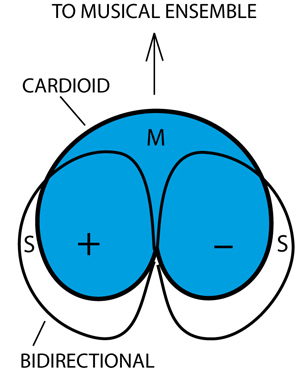
It uses a “mid” microphone facing the middle of the orchestra and a bidirectional microphone aiming to the sides. The middle mic is most commonly cardioid, but it can be any pattern.
In a device called a matrix, the signals from both mics are summed (mixed together) to produce the left-channel signal and are differenced (mixed in opposite polarity) to produce the right-channel signal.
You can remote-control the stereo spread by changing the mid/side ratio in the matrix. This remote control is useful at live concerts, where you can’t physically adjust the mics during the concert.
You can also control the stereo spread during mixdown rather than during the recording. For example, you can use a computer DAW to vary the stereo spread without using a matrix device.
A recording made with coincident mics is mono-compatible. If you expect that your recordings will be heard in mono (say, on TV), then you’ll probably want to use coincident methods.
Near-Coincident Pair
In listening tests, I compared a spaced-omni pair to a near-coincident pair. In the latter method, you angle apart two directional mics, and space their grilles a few inches apart horizontally (Figure 4).

Even a few inches of spacing increases the stereo spread compared to a coincident pair and adds a sense of ambient warmth or air to the recording. The greater the angle or spacing between mics, the greater the stereo spread.
How does this method work? Angling directional mics produces level differences between channels.
Spacing mics produces time differences. The level differences and time differences combine to create the stereo effect.
If the angling or spacing is too great, you get exaggerated separation. If the angling or spacing is too small, you hear a narrow stereo spread.
A common near-coincident method is the O.R.T.F. system, which uses two cardioids angled 110 degrees apart and spaced seven inches (17 cm) horizontally. (O.R.T.F. stands for Office de Radiodiffusion Television Française—French Broadcasting Organization.)
Usually this method gives accurate localization. That is, instruments at the sides of the orchestra are reproduced at or very near the speakers, and instruments halfway to one side are reproduced about halfway to one side.
The N.O.S. (Dutch) system uses two cardioids angled 90 degrees and spaced 12 inches (30 cm), while the D.I.N. (German) system is 90 degrees and 7.9 inches (20 cm).
Compared to O.R.T.F., those methods have less off-axis coloration because the mics are less angled away from the center instruments.
Also their 90 degrees angle between mics is easier to set up visually than the O.R.T.F. 110 degrees angle between mics.
Baffled Omni Pair
This method uses two omni mics, usually ear-spaced, and separated by a hard or padded baffle (Figure 5). To create stereo, it uses time differences at low frequencies and level differences at high frequencies.
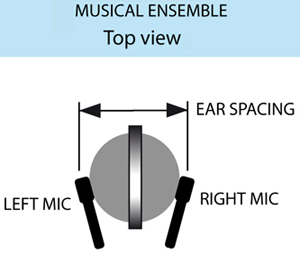
The spacing between mics creates time differences. The baffle creates a sound shadow (reduced high frequencies) at the mic farthest from the source. Between the two channels, there are spectral differences—differences in frequency response.
Some examples of baffled-omni pairs are the Schoeps or Neumann sphere microphones (Figure 6), the Jecklin Disk, and the Crown SASS-P MKII stereo microphone. The omni condenser mics used in the baffled-omni method have excellent low-frequency response.

A special form of the baffled-omni pair is binaural recording with an artificial head (dummy head). The head contains a microphone flush mounted in each ear. You record with these microphones and play back the recording over headphones.
This process can recreate the locations of the original performers and their acoustic environment with startling realism. You can clip a pair of miniature omni or cardioid mics onto the earpieces of eyeglasses.
Each mic is on the opposite side of your head, either in your ears or on your temples. To compensate for the acoustic effect of the head, the signals need some EQ (a broad dip around 3 kHz). Boundary (surface-mounted) mics can be used for any type of stereo miking.
Listening Comparison
I recorded a symphonic band simultaneously with a spaced-omni technique and a near-coincident technique. For spaced omnis I used two ACO Pacific MK224PH measurement mics at 12 feet from the ensemble and 30 inches apart. These phantom-powered units have extremely low noise, flat response from 20 Hz to 20 kHz, and an XLR output.
For near-coincident mics I used two Neumann KM-140 cardioid condensers in the N.O.S. configuration at 20 feet from the ensemble. I boosted 100 Hz by 6 dB on the KM-140s to make their low end match the omni pair.
To me at least, the spaced omni’s have a wider stereo stage and more envelopment. The equalized cardioids don’t sound quite as natural to me as the spaced omni’s, but they have sharper imaging. Feel free to draw your own conclusions.
Comparing The Four Techniques
Coincident pair:
• Uses two directional mics angled apart with grilles touching.
• Level differences between channels produce the stereo effect.
• Images are sharp.
• Stereo spread ranges from narrow to accurate.
• Signals are mono compatible.
Spaced pair:
• Uses two mics spaced a few feet apart, aiming straight ahead.
• Time differences between channels produce the stereo effect.
• Off-center images are diffuse.
• Stereo spread tends to be exaggerated unless a third center mic is used, or unless spacing is under 2 to 3 feet.
• Provides a warm sense of ambience.
• Provides excellent low-frequency response if you use omni condensers.
• Tends not to be mono compatible, but this may not be audible.
Near-coincident pair:
• Uses two directional mics angled apart and spaced a few inches apart horizontally.
• Level and time differences between channels produce the stereo effect.
• Images are sharp.
• Stereo spread tends to be accurate.
• The hall sounds more spacious than with coincident methods.
• Tends not to be mono compatible.
Baffled omni pair:
• Uses two omni mics, usually ear-spaced, with a baffle between them.
• Level, time, and spectral differences produce the stereo effect.
• Images are sharp.
• Stereo spread tends to be accurate.
• Excellent low-frequency response.
• Good imaging with headphones.
• The hall sounds more spacious than with coincident methods.
• Stereo spread is not adjustable except by panning the two channels toward the center.
• More conspicuous than other methods.
• Tends not to be mono compatible, but this might not be audible.


